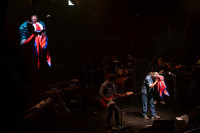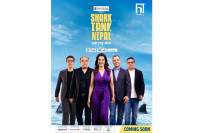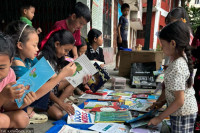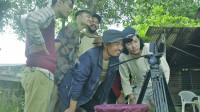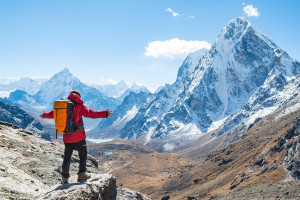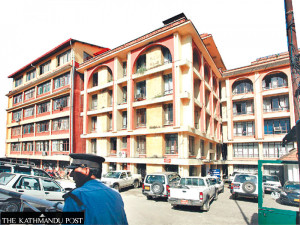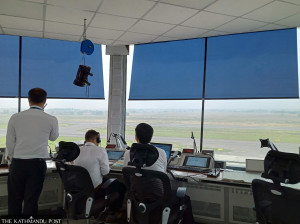Entertainment
Breaking the fourth wall
Works of art mean what we make of them.
Rachana Chettri
Works of art mean what we make of them. We look at a picture—a ‘realistic’ photograph, an ‘expressionistic’ painting, a work of ‘pop art’, as the case may be—and the ways in which the respective works have been grouped inevitably influence our viewing. We certainly do not approach a cubist painting the same way we approach a neo-classical one, and we live in an age where art has long been “anything (the artist) can get away with”.
An artist’s hand encroaches on the surface of a greyscale photograph. The image, of a building, a towel, a man and his bicycle—from a poster for the Siddhartha Art Gallery’s ongoing From Real to Surreal—A Meditative Journey exhibit—is by itself a work of art, if ‘art’ is to be taken in its most basic form as an aesthetically appealing representation of human creativity and imagination. The addition of the painter’s hand in fact distorts the image’s pure aesthetic appeal in certain ways and yet it also engages viewers in a dialogue with the photograph itself, not as a piece of art to be viewed and admired, but as a living, breathing creative force that is inviting them to be part of its very making. The greyscale image here is the ‘real’, the photograph as it actually exists; the artist and his paintbrush give the image its ‘surreal’ quality, both illogical, unnerving photorealistic details that lend new meaning to the work.
The exhibition, which features work by 13 Nepali artists—all students at Kathmandu University’s Centre for Art and Design—is a display of art on art in a way. The artists themselves are certainly deriving their art from the art of others: two Iranian photographers, Soha Embrahimzandi and Somaye Farhan, in this case. ‘The Dreammakers’, as Soha and Somaye are known, have been travelling the world on their bicycles for the better part of the past two years, living their dream and hoping to help others find the courage to live their own. Their journey has opened them up to a whole world of other dreams and experiences and their photographs certainly capture the beauty and magic of their own experience.
Soha and Somaye are perpetual travellers, wanderers who belong nowhere and yet everywhere, and who bring with them the knowledge and memories of people and places most of us will not meet and visit in a lifetime. Perhaps the wistful quality of their photographs is a reflection of their takers’ existence as passers-by, two people who will love each place they visit and yet not live there for more than a few months.
For the current exhibit, Soha and Somaye’s photographs have been reinterpreted and reworked by other artists to create the kind of art where artists are as visible as their artwork. Each brushstroke, each dab of paint, each ‘new’ element on the ‘original’ photograph says something about the hands that painted them and the minds that forged their existence into being. Bikash Tamakhu, Ramesh Kadayat, Tsewang Lama, Prajwal Bhattarai, Kiran Maharjan, Prakash Ranjit, Prabal Bikram Shah, Kiran Rai, Saroj Lamichhane, Mathias Plank, Kshitiz Gyawali, Niroj Maharjan and Pramod Thapa worked closely with Soha and Somaye to decide how the latter’s photographs might best be reworked. The result is a collection of 13 stunning mixed-media works that ask exhibition-goers to mull on the nature of art, of meaning, interpretation and ‘reality’.
Philosophical, psychological and aesthetical attempts at defining ‘the real’ come to mind as viewers move from one canvas to another, each referencing its ‘parent’ photograph in fascinating new ways. There is Kiran Rai’s Lights of Childhood, a black-and-white image where a little boy’s kite casts a shimmering aurora; the neon-green hues of the Northern Lights lending melancholic beauty to the image of childhood, spent frolicking across the open plains—as we all remember we did once, and to a grown-up’s eye, without a care in the world.
There is a not-so-subtle kind of humour in Niroj Maharjan’s Still Life, where a kitchen rack of stainless steel, of plates and glasses and pots and pans, finds itself reinterpreted as the background for a boiling stew, of root and leaf vegetables, on the surface, maybe, but possibly a lot more than that. Children’s games turn digital in Prabal Bikram Shah’s Level Up and there is an eerie, slightly disturbing beauty to Mathias Plank’s Resurrection.
The photographers’ favourite work though, one that was bought by a patron on the exhibit’s opening day, is Kiran Maharjan’s Key to Solitude. Maharjan has made the original photograph his very own in every sense in this work. He does not limit expression to the confines of a canvas but chooses to create his very own universe around it. The artist seems to be trying to get to a place beyond view, beyond imagination, maybe, but ends up with extraneous copies instead. The wooden pole, a pillar in someone’s kitchen somewhere in Nepal, has grown out of the picture in two pieces of tree bark that, although certainly not part of the photograph, mimic the object at its centre. There is a ‘copy key’, a facsimile the artist has created, hanging on the box on the left-hand side of the photograph, at the opposite end of the ‘real key’ in the photograph. A thaal (steel plate) that backgrounds the actual photograph has been turned into a full moon and the wooden pole itself turns into a steep, perhaps and rocky, hill interface where oriental-style temples lead up, ultimately to nowhere. There is confusion on the canvas here, and on others that are part of From Real to Surreal. Prajwal Bhattarai’s Infinite Threads for example, touch every corner of the photograph; like the sun’s rays almost, affecting, changing everything in their path.
And it is impossible to come out of the exhibition without having changed one’s view of ‘art’, although the same could also be said to be true for all ‘modern’ works of art. By presenting before the viewer two
alternate views and dimensions of reality, the artists are prodding them to reflect on what is and what isn’t, or perhaps more importantly what is and what can be. The options here are truly limitless.




 19.42°C Kathmandu
19.42°C Kathmandu


